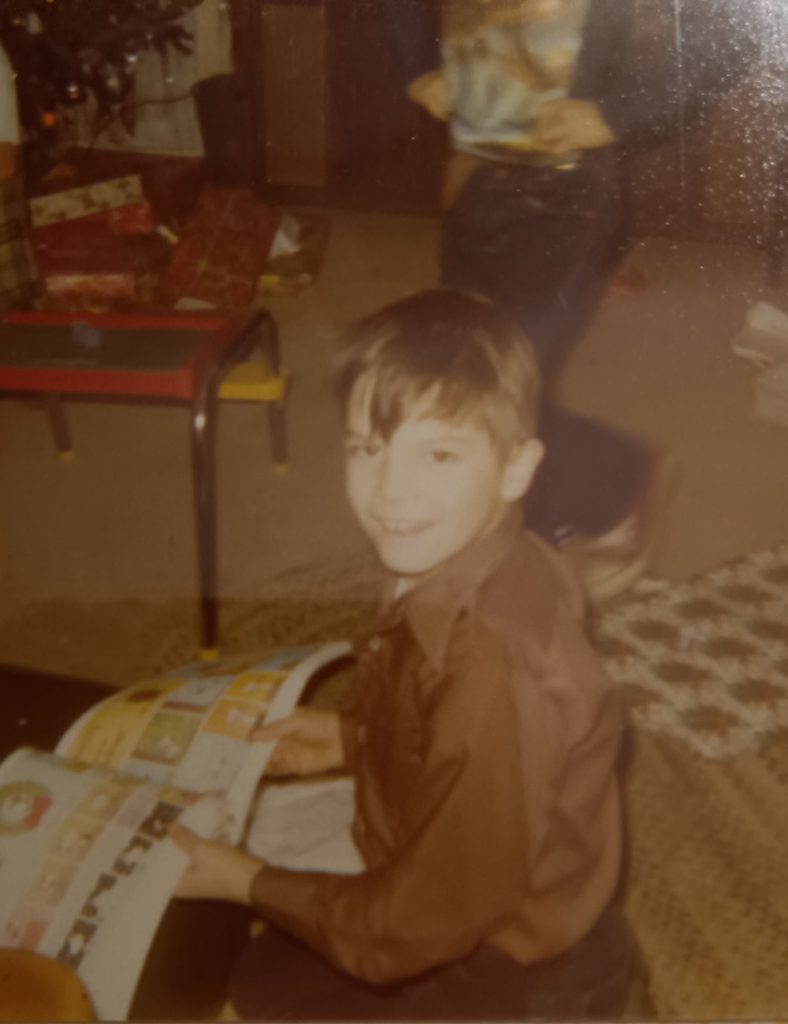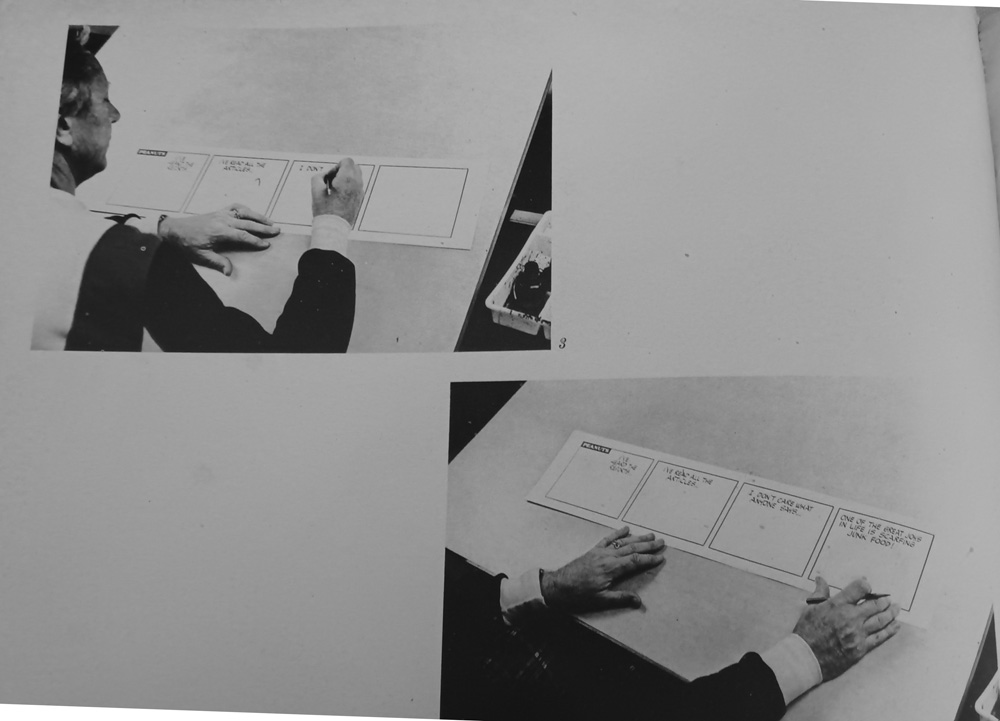The Magic of Finding Your Flow
Posted
As I approach a new school year in two weeks, I will probably be facing a week of pre-planning that almost inevitably focus too much on data, tested standards, and compliance to curricular conformity. Our focus will be on standardized curriculum, standardized tests, and standardized out comes, with the requisite talk about meeting the individual needs of learners – by which we actually mean trying to compensate for their individuality in order to make them more standardized.
It shouldn’t be this way. It doesn’t have to be this way.
What if we focused instead on helping students find discover and develop the things they are interested in?
I recently visited my mom in Upstate New York, going back to the house I grew up in. I found my photo book on the shelf, and looking through it, I was struck by several things – but I’ll focus on just one here: a photo of me, age 8, at Christmas time in 1975. I am holding in my hands a book that will change my life.

The book was Peanuts Jubilee: My Life and Art with Charlie Brown and Others by Charles M. Schulz, a book commemorating the 25th anniversary of the comic strip Peanuts. It strikes me that I look very happy in this photo. I was. I was already a Peanuts fan, reading the strip in the newspaper but also in paperback collections. But this book was not just a collection of strips (though it was that). The book was also Schulz’s memoir about his childhood and the creation of the strip. I poured over it dozens of times, practically memorizing it.
The best pages in the book, however, were the pages featuring step-by-step photos of Schulz actually drawing a strip.

Somehow, the magic of those pages solidified my desire to be a cartoonist. I began drawing my own comic strips in earnest shortly thereafter, and have continued drawing them, at least on and off, ever since.
This anecdote is about the power of reading – but it is, in particular, about the power of reading to help me find one of my many sources of flow: drawing comic strips. I might have started drawing comic strips without this book – I already liked drawing – but I suspect it spurred me to really give not just drawing a try, but to try writing funny words combined with funny drawings. To try what is now called sequential art.
I have not become a rich and famous cartoonist like Charles Schulz. I am not as well known as I would like to be. But I think I have found an audience and have, in some small way, helped both myself and my readers stick with a profession that can be both absurd and frustrating. More to the point, I have found, for 23 years now, an activity that puts me in a state of flow and is thoroughly enjoyable.
I have come to believe there is something magical, perhaps even holy, about finding an activity (or activities) that completely immerse you, that help you know who you are even as you forget yourself as you do them.
Just yesterday, on CBS Sunday Morning (the go-to show for my wife and and me; it’s excellent with coffee and cinnamon rolls), I was struck by a common thread in several stories. One story was about the death of singer Tony Bennett. He discovered singing, and did it all his life. Even after Alzheimer’s had begun to ravage his memory, he still managed a final concert with Lady Gaga. He had forgotten many things, but he still knew those glorious American standards. He was a man who had found the magic of his flow experience. Apparently he continued to sing to almost the very end.
Another story featured a girl who had discovered bee-keeping at a very young age and feels certain that it will be her life’s work. Yet another story featured a young boy who is a musical prodigy at age 7, playing several instruments, doing vocals, and mixing his own tracks on a computer.
I just got cast in two small parts in a play (another flow experience of mine), How to Succeed in Business Without Really Trying, at a local theater. As I sat at the first read-through, I saw young people and not-so-young people who were all there because performing is something they love. Flow again.
Yes, we all need to make a living, and if you can combine what you love with a job that will support you, that’s great. But we also need to help students make a life, and that includes finding the things that are flow experiences for you and making time to enjoy them, whether they are on the job or off.
Too many people settle for passive media consumption these days – not just our students, but many adults as well. We need to make schools places where students can find their flow experiences, find the magic of doing things they love. I had teachers who didn’t appreciate my endless doodling and writing, but others appreciated it and found ways to encourage me to bring my enthusiasms into class. Mrs. Gottung let me create dittos to teach cartooning to the rest of my third grade reading class. In 11th grade cinematography I created cell animation. In 12th grade speech class, I presented a how-to speech about how I created cell animation.
Shortly after receiving Peanuts Jubilee for Christmas, I began teaching cartooning classes to my younger sister and younger siblings of my best friends. My first teaching gig was in high school, where I taught comic strip creation in the public library system. So teaching has been one of my flow experiences for a long time.
I still love cartooning. I also still love teaching, as do thousands and thousands of others like me.
When I draw comics, I love deciding what to write a strip about. I love writing the script and coming up with irony. I love penciling the drawings and getting the facial expressions and poses just right; I love inking the final lines and coloring the strips. When I teach I love choosing themes, choosing texts, creating writing activities and assignments that help students to express themselves and find their flow. I love interacting with students and listening to and leading class discussion. Teaching itself is a flow experience for me.
Or it is when I’m allowed to do it. For the past 20 years or so, it seems that the powers that be want to make teaching into a joyless, standardized, rote, uncreative task instead of a joyful, student-focused, creative flow experience.
And they wonder why we can’t find teachers.
Somewhere along the way, perhaps with good intentions, our desire to make teaching measurable morphed and made schools into places where the magic of human flow is crushed for both students and teachers.
What if we tried to make school a place where everyone, students, teachers, administrators, and support staff, could discover the magic of flow? What would that look like?
Some of us still make it happen – but it gets harder and harder to fight the system that tries to kill flow.
Shouldn’t schools be about encouraging human happiness, flow, and potential? The answer seems obvious.
Merry Christmas in July.